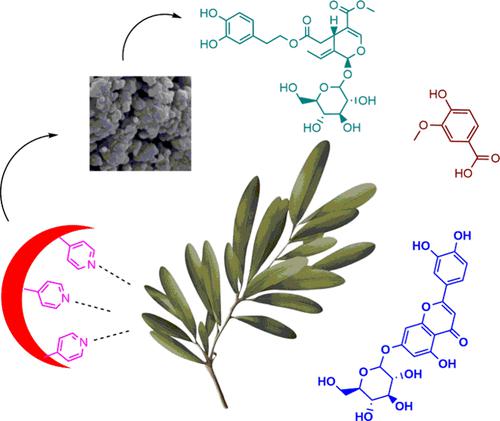当前位置:
X-MOL 学术
›
J. Chem. Eng. Data
›
论文详情
Our official English website, www.x-mol.net, welcomes your feedback! (Note: you will need to create a separate account there.)
Competitive Adsorption of Phenolic Acids, Secoiridoids, and Flavonoids in Quercetin Molecularly Imprinted Polymers and Application for Fractionation of Olive Leaf Extracts
Journal of Chemical & Engineering Data ( IF 2.6 ) Pub Date : 2024-02-28 , DOI: 10.1021/acs.jced.3c00543 Ayssata Almeida 1 , Cláudia Martins 1 , Rolando C. S. Dias 1 , Mário Rui P. F. N. Costa 2
Journal of Chemical & Engineering Data ( IF 2.6 ) Pub Date : 2024-02-28 , DOI: 10.1021/acs.jced.3c00543 Ayssata Almeida 1 , Cláudia Martins 1 , Rolando C. S. Dias 1 , Mário Rui P. F. N. Costa 2
Affiliation

|
The competitive adsorption of phenolic acids, secoiridoids, and flavonoids in a molecularly imprinted polymer (MIP) functionalized with 4-vinylpiridine (4VP) moieties is analyzed here considering vanillic acid, oleuropein, and quercetin as reference molecules. Measured adsorption isotherms highlight a much stronger binding capacity of the quercetin-MIP particles toward quercetin as compared with vanillic acid and oleuropein. The acquired data were used to design and scale-up sorption/desorption processes aiming at the fractionation of olive leaf extracts. We show that a simple adsorption process, avoiding many pre-preparation steps, is possible when working at a high extract concentration due to the strong binding capacity of the MIP for flavonoids, even when using aqueous mixtures with a large alcoholic content. Solvent-gradient/temperature-swing desorption led to a sequence of fractions with enrichment of non-flavonoids at low alcoholic content while glycosylated flavonoids were enriched in fractions with 40% < alcohol content < 80%. Enrichment factors of 13 and 12 were measured for luteolin-7-O-glucoside and apigenin-7-O-glucoside, respectively. Flavonoid aglycones were enriched in fractions with alcohol content >80% (enrichment factors >20 for luteolin and quercetin). The findings reported here demonstrate the usefulness of the developed materials and sorption/desorption conditions for agricultural residue valorization and circular bioeconomy.
中文翻译:

槲皮素分子印迹聚合物中酚酸、环环烯醚萜和黄酮类化合物的竞争吸附及其在橄榄叶提取物分级分离中的应用
本文以香草酸、橄榄苦苷和槲皮素为参考分子,分析了用 4-乙烯基吡啶 (4VP) 部分功能化的分子印迹聚合物 (MIP) 中酚酸、环烯醚萜和类黄酮的竞争吸附。测量的吸附等温线表明,与香草酸和橄榄苦苷相比,槲皮素-MIP 颗粒对槲皮素的结合能力要强得多。获得的数据用于设计和扩大吸附/解吸过程,旨在分离橄榄叶提取物。我们表明,由于 MIP 对黄酮类化合物具有很强的结合能力,即使在使用酒精含量较高的水性混合物时,在高提取物浓度下工作时,也可以实现简单的吸附过程,避免许多预制备步骤。溶剂梯度/变温解吸产生了一系列在低酒精含量下富集非黄酮类化合物的馏分,而在40%<酒精含量<80%的馏分中富集了糖基化黄酮类化合物。木犀草素-7- O-葡萄糖苷和芹菜素-7- O-葡萄糖苷的富集因子分别为13和12。黄酮苷元在酒精含量>80%的馏分中富集(木犀草素和槲皮素的富集因子>20)。这里报告的研究结果证明了所开发的材料和吸附/解吸条件对于农业残留物增值和循环生物经济的有用性。
更新日期:2024-02-29
中文翻译:

槲皮素分子印迹聚合物中酚酸、环环烯醚萜和黄酮类化合物的竞争吸附及其在橄榄叶提取物分级分离中的应用
本文以香草酸、橄榄苦苷和槲皮素为参考分子,分析了用 4-乙烯基吡啶 (4VP) 部分功能化的分子印迹聚合物 (MIP) 中酚酸、环烯醚萜和类黄酮的竞争吸附。测量的吸附等温线表明,与香草酸和橄榄苦苷相比,槲皮素-MIP 颗粒对槲皮素的结合能力要强得多。获得的数据用于设计和扩大吸附/解吸过程,旨在分离橄榄叶提取物。我们表明,由于 MIP 对黄酮类化合物具有很强的结合能力,即使在使用酒精含量较高的水性混合物时,在高提取物浓度下工作时,也可以实现简单的吸附过程,避免许多预制备步骤。溶剂梯度/变温解吸产生了一系列在低酒精含量下富集非黄酮类化合物的馏分,而在40%<酒精含量<80%的馏分中富集了糖基化黄酮类化合物。木犀草素-7- O-葡萄糖苷和芹菜素-7- O-葡萄糖苷的富集因子分别为13和12。黄酮苷元在酒精含量>80%的馏分中富集(木犀草素和槲皮素的富集因子>20)。这里报告的研究结果证明了所开发的材料和吸附/解吸条件对于农业残留物增值和循环生物经济的有用性。



























 京公网安备 11010802027423号
京公网安备 11010802027423号